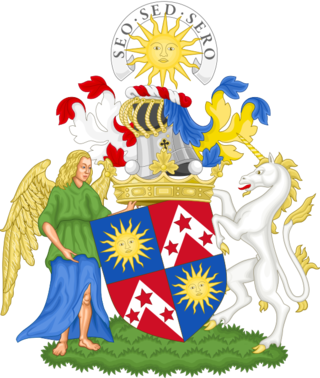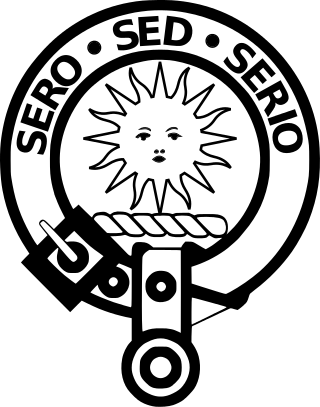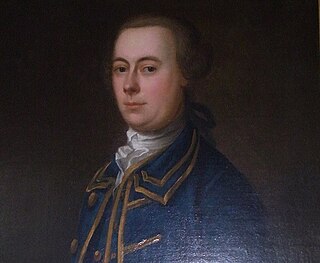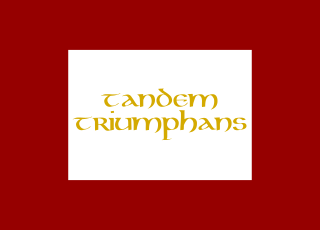Related Research Articles

The Battle of Culloden took place on 16 April 1746, near Inverness in the Scottish Highlands. A Jacobite army under Charles Edward Stuart was decisively defeated by a British government force commanded by the Duke of Cumberland, thereby ending the Jacobite rising of 1745.

Marquess of Lothian is a title in the Peerage of Scotland, which was created in 1701 for Robert Kerr, 4th Earl of Lothian. The Marquess of Lothian holds the subsidiary titles of Earl of Lothian, Earl of Lothian, Earl of Ancram (1633), Earl of Ancram, Viscount of Briene (1701), Lord Newbattle (1591), Lord Jedburgh (1622), Lord Kerr of Newbattle (1631), Lord Kerr of Nisbet, Langnewtoun, and Dolphinstoun (1633), Lord Kerr of Newbattle, Oxnam, Jedburgh, Dolphinstoun and Nisbet (1701), and Baron Ker, of Kersheugh in the County of Roxburgh (1821), all but the last in the Peerage of Scotland. As The Lord Ker in the Peerage of the United Kingdom, previous marquesses sat in the House of Lords before 1963, when Scottish peers first sat in the House of Lords in their own right. The holder of the marquessate is also the Chief of Clan Kerr.

The Battle of Prestonpans, also known as the Battle of Gladsmuir, was fought on 21 September 1745, near Prestonpans, in East Lothian, the first significant engagement of the Jacobite rising of 1745.

Clan Kerr is a Scottish clan whose origins lie in the Scottish Borders. During the Middle Ages, it was one of the prominent border reiver clans along the present-day Anglo-Scottish border and played an important role in the history of the Border country of Scotland.

Clan Scott is a Scottish clan and is recognised as such by the Lord Lyon King of Arms. Historically the clan was based in the Scottish Borders.

The Battle of Falkirk Muir, or Battle of Falkirk, took place near Falkirk, Scotland, on 17 January 1746 during the Jacobite rising of 1745. A narrow Jacobite victory, it had little impact on the campaign.

General William Henry Kerr, 4th Marquess of Lothian, was a Scottish nobleman, British soldier and politician, the eldest son of William Kerr, 3rd Marquess of Lothian. He was styled Master of Jedburgh until 1722, Lord Jedburgh from 1722 to 1735, and Earl of Ancram from 1735 to 1767. As the Earl of Ancram, he distinguished himself during the War of the Austrian Succession.
William Kerr, 3rd Marquess of Lothian, was a Scottish nobleman, styled Master of Jedburgh from 1692 to 1703 and Lord Jedburgh from 1703 to 1722.

Sir Harry Munro, 7th Baronet was 25th Baron and the 28th chief of the Clan Munro. He was a Scottish soldier and politician. He was loyal to the Hanoverian dynasty and served as a captain in Loudon's Highlanders Regiment 1745–48.

Clan Murray is a Highland Scottish clan. The chief of the Clan Murray holds the title of Duke of Atholl. Their ancestors were the Morays of Bothwell who established the family in Scotland in the 12th century. In the 16th century, descendants of the Morays of Bothwell, the Murrays of Tullibardine, secured the chiefship of the clan and were created Earls of Tullibardine in 1606. The first Earl of Tullibardine married the heiress to the Stewart earldom of Atholl and Atholl therefore became a Murray earldom in 1626. The Murray Earl of Atholl was created Marquess of Atholl in 1676 and in 1703 it became a dukedom. The marquess of Tullibardine title has continued as a subsidiary title, being bestowed on elder sons of the chief until they succeed him as Duke of Atholl.

Clan MacBean, is a highland Scottish clan and is a member and historic sept of Clan Chattan.

Clan Ogilvy, also known as Clan Ogilvie, is a Highland Scottish clan. Originating from Angus, Scotland, the progenitor of the Clan received a barony from King William the Lion in 1163. In 1491, King James IV elevated Sir James Ogilvy as Lord Ogilvy of Airlie.

Clan MacLaren is a Highland Scottish clan. Traditional clan lands include the old parish of Balquhidder which includes the villages of Lochearnhead and Strathyre, and is about 18 miles (29 km) long and 7 miles (11 km) broad, spanning 54,675 acres (22,126 ha), long known as "Maclaren Country".
Loudon's Highlanders, or the 64th Highlanders, or Earl of Loudon's Regiment of Foot, was an infantry regiment of the British Army.
Sir George Munro of Culcairn was a Scottish soldier of the 18th century from Ross-shire, Scotland. He commanded the 3rd Independent Highland Company from 1714 to 1716, fought at the Battle of Glen Shiel in 1719, led the 6th Company in formation of the "Black Watch" in 1725, the 8th Company of Black Watch when it was regimented in 1739 and again commanded an Independent Highland Company in 1745–46. He was shot in error in 1746.
The Independent Highland Companies were irregular militia raised from the Scottish clans of the Scottish Highlands by order of the Scottish government between 1603 and 1760 in order to help keep the peace and enforce the law in the Highlands and were recognized as such by the government. The officers of the Independent Highland Companies were commissioned as officers of the British Army but the Independent Companies were not recognized as official regiments of the line of the army. The Independent Highland Companies were the progenitors of the Highland Regiments of the British Army that began when ten Independent Highland Companies were embodied to form the Earl of Crawford's Highland Regiment that was numbered the 43rd Regiment of Foot in 1739.
The Campbell of Argyll Militia also known as the Campbell militia, the Argyll militia, or the Argyllshire men, was an irregular militia unit formed in 1745 by John Campbell, 4th Duke of Argyll to oppose the Jacobite rising of 1745.

The siege of Culloden House took place on the night of 15/16 October 1745 and was part of the Jacobite rising of 1745. 200 men of the Jacobite Clan Fraser of Lovat attempted to capture Duncan Forbes, Lord Culloden who was the Lord President of the Court of Session, the most senior legal officer in Scotland.

The Jacobite Army, sometimes referred to as the Highland Army, was the military force assembled by Charles Edward Stuart and his Jacobite supporters during the 1745 Rising that attempted to restore the House of Stuart to the British throne.

An Incident in the Rebellion of 1745 is an oil painting painted by Swiss-born artist David Morier sometime between 1746 and 1765. It is currently part of the art collection of the British royal family. The painting depicts a scene during the 1746 Battle of Culloden, in which a group of Jacobite Army troops charge against a line of government soldiers.
References
- ↑ "Person Page". www.thepeerage.com.
- ↑ Carrell, Severin; correspondent, Scotland (7 October 2010). "Vivaldi flute concerto discovered". The Guardian– via www.theguardian.com.
{{cite news}}:|last2=has generic name (help) - ↑ John Home Esq – 'The History of the Rebellion in the Year 1745 (published 1802, London, printed by A. Strahan, New-street Square, for T. Cadell, Jun. and W. Davies in the Strand); page 237-238: Lord Robert Ker (second son of the Marquis of Lothian), Captain of grenadiers in Burrel's regiment.... when the Highlanders broke into Burrel's, he received (it is said) the foremost man upon his spontoon, and was killed instantly, with many wounds
- ↑ History of the Transactions in Scotland in the years 1715–16, and 1745–46, by George Charles (Printed at Stirling by j. Fisher & Co., 1816). Volume 1 (of 2). Page 300, Battle of Culloden – Return of the names of the Officers, and numbers of Non-commissioned Officers, Private Men, and Horses, killed and wounded: Barrel's. – Captain Lord Robert Ker, and 16 men, killed....
- ↑ The Letters of Horace Walpole, Earl of Orford, Vol. II 1744–1753 (1840 pub. Richard Bentley), page 136 & footnote, Letter to Sir Horace Mann, 1 August 1746: ..the Marquis of Lothian in weepers for his son who fell at Culloden... Footnote: William Ker, third Marquis of Lothian. Lord Robert Kerr, who was killed at Culloden, was his second son. – D.
- ↑ The History of the Rebellion in Scotland in 1745 by John Home Esq (Edinburgh 1822, Printed for Peter Brown, 37, Nicolson Street; and Ogle, Duncan, & Co. London). Chapter XI, page 171: The Person of the greatest distinction who fell that memorable day was Lord Robert Ker, second son of the Marquis of Lothian, captain of grenadiers in Burrel's [sic] regiment.
- ↑ James Logan, The Clans of the Scottish Highlands (Ackermann & Co., Strand, 1847)
- ↑ Arthur Llewellyn Griffiths, Wild Scottish Clans and Bonnie Prince Charlie (1875), page 85
- ↑ Culloden Tales: Stories from Scotland's Most Famous Battlefield, by Hugh G. Allison (Penguin Random House, 2007). Page 128: The Clan Chattan Regiment charged the government's left flank, where an eyewitness account describes the fall of Captain Lord Robert Kerr of Barrell's Regiment, 'his head being cleft from crown to collarbone' by Major Gillies MacBean